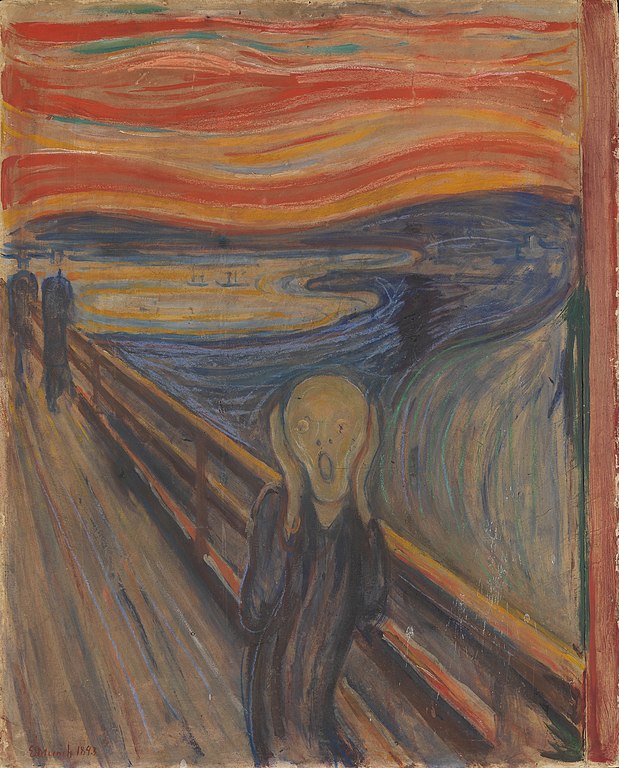Differential Cognitive Treatment of Polythematic Delusions and Generalised Anxiety Disorder
English translation of a paper published in french under the title “Traitement cognitif différentiel des délires polythématiques et du trouble anxieux généralisé“, in the Journal de Thérapie Comportementale et Cognitive, 2011, vol. 21-4, pp. 121-125.
Schizophrenia is often associated with other physical and mental problems. Generalized anxiety disorder is notably one of the comorbid disorders which is often linked to schizophrenia. The association of polythematic delusions and of ideas resulting from generalized anxiety disorder complicates the exercise of the corresponding cognitive therapy, for the resulting ideas are most often inextricably intertwined. In what follows, we endeavour to propose a methodology for the differential treatment of polythematic delusions inherent to schizophrenia when combined with ideas originating from generalized anxiety disorder. We propose, with regard to the corresponding content of delusions, an analysis which allows under certain conditions, to separate the content associated with polythematic delusions and the one that relates to generalized anxiety disorder, in order to facilitate the exercise of the corresponding cognitive therapy.
Polythematic Delusions and Logico-Theoretical vs. Experimentalist Turn of Mind
A paper published in the Journal for Neurocognitive Research, Vol. 2013, 55, No. 1-2.
This article aims to contribute to cognitive therapy of polythematic delusions by proposing a preliminary step to the implementation of traditional cognitive therapy, based on the construction of alternative hypotheses to delusions and testing of the latter. This additional step resides in the construction in the patient of the necessary skills to use the general experimentalist method of knowledge acquisition. Such an approach is based on the contrast between the logico-theoretical and the experimentalist turn of mind. Some elements such as to allow any such construction in the patient are then described and analyzed. pdf
On the Plausibility of Psychotic Hallucinations

A paper published in the Journal for Neurocognitive Research, Vol. 53, No 1-2 (2011).
In this paper, we describe several factors that can contribute, from the patient’s viewpoint, to the plausibility of psychotic hallucinations. We sketch then a Plausibility of Hallucinations Scale, consisting of a 50-item questionnaire, which aims at evaluating the degree of plausibility of hallucinations. We also emphasize the utility of pointing out to the patient the several factors that contribute to the plausibility of his/her hallucinations, in the context of cognitive therapy for schizophrenia. pdf
A Logical Defence of Maher’s Model of Polythematic Delusions
English translation of a paper published in French in Philosophiques, autumn 2008, under the title “Une défense logique du modèle de Maher pour les délires polythématiques”.
In this paper, we proceed to describe a model for the formation and maintenance of polythematic delusions encountered in schizophrenia, which is in adequation with Brendan Maher’s account of delusions. Polythematic delusions are considered here as the conclusions of arguments triggered by apophenia that include some very common errors of reasoning such as post hoc fallacy and confirmation bias. We describe first the structure of reasoning which leads to delusions of reference, of telepathy and of influence, by distinguishing between the primary, secondary, tertiary and quaternary types of delusional arguments. These four levels of arguments correspond to a stage the nature of which is respectively instantial, inductive, interpretative at a monothematic level and interpretative at a polythematic level. We also proceed to identify accurately the fallacious steps in the corresponding reasoning. We expose then the role of apophenia in the elaboration of delusional ideas. Lastly, we describe the role played by the hallucinations in the present model. pdf
Theory of Cognitive Distortions: Over-generalisation and Labeling
English translation of a paper published in French in the Journal de Thérapie Comportementale et Cognitive, 2009, 19-4, pages 136-140 under the title “Théorie des distorsions cognitives : la sur-généralisation et l’étiquetage”.
In a previous article (Complements to a theory of cognitive distorsions, Journal de Thérapie Comportementale et Cognitive, 2007), we introduced some elements aimed at contributing to a general theory of cognitive distortions. Based on the reference class, the duality and the system of taxa, these elements allow to define the general cognitive distortions as well as the specific cognitive distortions. This model is extended here to the description of two other classical cognitive distortions: over-generalisation and mislabelling. The definition of the two latter cognitive distortions is based on prior differentiation between three levels of reasoning: primary, secondary and ternary pathogenic arguments. The latter analysis also leads to define two other cognitive distortions which insert themselves into this framework: ill-grounded inductive projection and confirmation bias. pdf
Theory of Cognitive Distortions: Personalisation
English translation of a paper published in French in the Journal de Thérapie Comportementale et Cognitive, 2010, 20-2, pages 51-55 under the title “Théorie des distorsions cognitives : la personnalisation”.
In a previous paper (Complements to a theory of cognitive distorsions, Journal de Thérapie Comportementale et Cognitive, 2007), we did present some elements aimed at contributing to a general theory of cognitive distortions. Based on the reference class, the duality and the system of taxa, these elements led to distinguish between the general cognitive distortions (dichotomous reasoning, disqualification of one pole, minimisation, maximisation) and the specific cognitive distortions (disqualifying the positive, selective abstraction, catastrophism). By also distinguishing between three levels of reasoning – the instantiation stage, the interpretation stage and the generalisation stage – we did also define two other cognitive distortions: over-generalisation and mislabelling (Théorie des distorsions cognitives : la sur-généralisation et l’étiquetage, Journal de Thérapie Comportementale et Cognitive, 2009). We currently extend this model to another classical cognitive distortion: personalisation.
Theory of Cognitive Distortions: Application to Generalised Anxiety Disorder

English translation and postprint (with additional illustrations) of a paper published in French under the title “Théorie des distorsions cognitives : application à l’anxiété généralisée” in the Journal de Thérapie Comportementale et Cognitive, 2008, 18, pp. 127-131. This article follows the contribution to the general theory of cognitive distortions exposed in “Complements to a theory of cognitive distorsions” (Journal de Thérapie Comportementale et Cognitive, 2007). The elements described, namely the reference class, the duality and the system of taxa, are applied here to generalised anxiety disorder. On the one hand, these elements allow to describe the cognitive distortions which are specific to generalised anxiety disorder, consistent with recent work emphasising the role played uncertain situations relative to future events. On the second hand, they allow to define a type of structured reasoning, of inductive nature, which leads to the formation and maintenance of anxious ideas. pdf
Complements to a Theory of Cognitive Distortions

English preprint of a paper published in French under the title “Compléments pour une théorie des distorsions cognitives”, in the Journal de Thérapie Comportementale et Cognitive, 2007, 17-2, pp. 84-88.
The purpose of this study is to describe a conceptual framework for cognitive distortions, which notably allows to specify more accurately their intrinsic relationships. This conceptual framework aims at inserting itself within the apparatus of cognitive therapy and of critical thinking. The present analysis is based on the following fundamental concepts: the reference class, the duality and the system of taxa. With the help of these three notions, each cognitive distortion can be defined. A distinction is also made between, on the one hand, general cognitive distortions and on the other hand, specific cognitive distortions. The present model allows then to define within the same conceptual framework the general cognitive distortions such as dichotomous reasoning, disqualifying a given pole, minimisation and maximisation. It also allows to describe as specific cognitive distortions: disqualifying the positive, selective abstraction and catastrophism. Furthermore, the present model predicts the existence of two other general cognitive distortions: the omission of the neutral and requalifying in the other pole. pdf)
This article is cited in:
-
Maladaptive cognitions and emotion regulation in posttraumatic stress disorder, Ouhmad, N., El-Hage, W., Combalbert, N. (2023) Neuropsychiatrie
-
Naren D. Selvaratnam, Ooi Boon Keat, Jacquline Tham. (2023). Conversational Difficulties, Cognitive Distortions, and Leadership Efficacy of Minority Students in Sri Lankan Public Universities. Journal for ReAttach Therapy and Developmental Diversities, 6(10s), 395–408.
-
Development of the Cognitive Distortion Scale for Adults (EDC-A): Study of psychometric properties in the general population and association with anxiety and depression [Création de l’Échelle de Distorsions Cognitives pour adultes (EDC-A) : étude des propriétés psychométriques en population générale et association avec l’anxiété et la dépression], Robert, A., Combalbert, N., Pennequin, V., Deperrois, R., Ouhmad, N. (2023) Psychologie Francaise
-
Cognitive distortions of victims: Symptoms and therapeutic lever, Sorel O., Lavandier A., Tortes Saint-Jammes J. (2023) Annales Médico-psychologiques
-
Cognitive distortions, anxiety, and depression in individuals suffering from PTSD, Ouhmad, N., Deperrois, R., El Hage, W., Combalbert, N. (2023) International Journal of Mental Health
-
Links between cognitive distortions and cognitive emotion regulation strategies in non-clinical young adulthood, Deperrois, R., Combalbert, N. (2022) Cognitive Processing
-
For a Typology of Auditory Verbal Hallucinations Based on their Content, Franceschi, P. (2020) Activitas Nervosa Superior
-
Study of cognitive distortion profiles on anxiety and depressive states in ordinary people [Étude des profils de distorsion cognitive en fonction des états anxieux et dépressifs chez des adultes tout-venant] Robert, A., Combalbert, N., Pennequin, V. (2018) Annales Medico-Psychologiques
-
Bipolar disorder, self-stigma and cognitive restructuring: A first attempt to support [Trouble bipolaire, auto-stigmatisation et restructuration cognitive: une première tentative de prise en charge] Richard-Lepouriel, H. (2017) Journal de Therapie Comportementale et Cognitive
-
The influence of cognitive biases in non-clinical adult’s anxiety [L’influence des biais cognitifs sur l’anxiété chez des adultes non cliniques] Pennequin, V., Combalbert, N. (2017) Annales Medico-Psychologiques
-
Theory of cognitive distortions: Personalisation [Théorie des distorsions cognitives: La personnalisation] Franceschi, P. (2010) Journal de Therapie Comportementale et Cognitive
-
Theory of cognitive distortions: Over-generalisation and mislabeling [Théorie des distorsions cognitives : la sur- généralisation et l’étiquetage] Franceschi, P. (2009) Journal de Therapie Comportementale et Cognitive
-
Theory of cognitive distortions: Application to generalised anxiety disorder [Théorie des distorsions cognitives: Application à l’anxiété généralisée] Franceschi, P. (2008) Journal de Therapie Comportementale et Cognitive
For a Typology of Auditory Verbal Hallucinations Based on their Content
A paper published in Activitas nervosa Superior (2020), 62, pages 104–109.
Auditory verbal hallucinations (AVHs) are a common symptom of schizophrenia. Studies have focused on a classification of AVHs, based on different criteria. Subtypes of AVHs have been defined, distinguishing according to whether they are internal/external, single/multiple, unimodal/multimodal, benevolent/malevolent, permanent/intermittent, etc. The purpose of this study is to propose a classification of AVHs based on their content. We first identify the subtype that is directly associated with the polythematic delusions inherent in schizophrenia. Second, we distinguish subtypes related to other comorbid psychiatric disorders associated with schizophrenia in the patient: generalized anxiety disorder, depression, body dysmorphic disorder, etc. Finally, we suggest that such a differentiation could allow a correlative adaptation of the corresponding cognitive-behaviour therapy. pdf